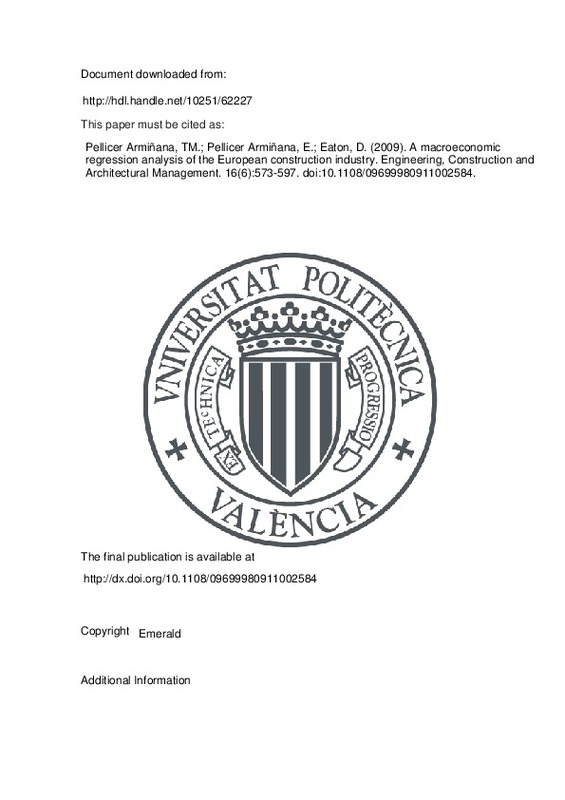Bon, R. (1988). Direct and indirect resource utilisation by the construction sector. Habitat International, 12(1), 49-74. doi:10.1016/0197-3975(88)90039-2
Bon, R., & Crosthwaite, D. (2001). The future of international construction: some results of 1992-1999 surveys. Building Research & Information, 29(3), 242-247. doi:10.1080/096132101300099790
Bon, R., & Pietroforte, R. (1990). Historical comparison of construction sectors in the United States, Japan, Italy and Finland using input-output tables. Construction Management and Economics, 8(3), 233-247. doi:10.1080/01446199000000021
[+]
Bon, R. (1988). Direct and indirect resource utilisation by the construction sector. Habitat International, 12(1), 49-74. doi:10.1016/0197-3975(88)90039-2
Bon, R., & Crosthwaite, D. (2001). The future of international construction: some results of 1992-1999 surveys. Building Research & Information, 29(3), 242-247. doi:10.1080/096132101300099790
Bon, R., & Pietroforte, R. (1990). Historical comparison of construction sectors in the United States, Japan, Italy and Finland using input-output tables. Construction Management and Economics, 8(3), 233-247. doi:10.1080/01446199000000021
Clarke, L., & Wall, C. (2000). Craft versus industry: the division of labour in European housing construction. Construction Management and Economics, 18(6), 689-698. doi:10.1080/014461900414745
Dikmen, I., Birgonul, M. T., & Budayan, C. (2009). Strategic Group Analysis in the Construction Industry. Journal of Construction Engineering and Management, 135(4), 288-297. doi:10.1061/(asce)0733-9364(2009)135:4(288)
Drewer, S. (2001). A perspective of the international construction system. Habitat International, 25(1), 69-79. doi:10.1016/s0197-3975(00)00027-8
Druker, J., & Croucher, R. (2000). National collective bargaining and employment flexibility in the European building and civil engineering industries. Construction Management and Economics, 18(6), 699-709. doi:10.1080/014461900414754
Fellini, I., Ferro, A., & Fullin, G. (2007). Recruitment processes and labour mobility: the construction industry in Europe. Work, Employment and Society, 21(2), 277-298. doi:10.1177/0950017007076635
Hua, G. B., & Pin, T. H. (2000). Forecasting construction industry demand, price and productivity in Singapore: the BoxJenkins approach. Construction Management and Economics, 18(5), 607-618. doi:10.1080/014461900407419
Janssen, J. (2000). The European construction industry and its competitiveness: a construct of the European Commission. Construction Management and Economics, 18(6), 711-720. doi:10.1080/014461900414763
Lillie, N., & Greer, I. (2007). Industrial Relations, Migration, and Neoliberal Politics: The Case of the European Construction Sector. Politics & Society, 35(4), 551-581. doi:10.1177/0032329207308179
Lopes, J., Ruddock, L., & Ribeiro, F. L. (2002). Investment in construction and economic growth in developing countries. Building Research & Information, 30(3), 152-159. doi:10.1080/09613210110114028
Miozzo, M., & Dewick, P. (2002). Building competitive advantage: innovation and corporate governance in European construction. Research Policy, 31(6), 989-1008. doi:10.1016/s0048-7333(01)00173-1
Ofori, G. (2000). Globalization and construction industry development: research opportunities. Construction Management and Economics, 18(3), 257-262. doi:10.1080/014461900370627
Ofori, G. (2003). Frameworks for analysing international construction. Construction Management and Economics, 21(4), 379-391. doi:10.1080/0144619032000049746
Pietroforte, R., & Gregori, T. (2003). An input-output analysis of the construction sector in highly developed economies. Construction Management and Economics, 21(3), 319-327. doi:10.1080/0144619032000056153
Pries ∗, F., & Janszen, F. (1995). Innovation in the construction industry: the dominant role of the environment. Construction Management and Economics, 13(1), 43-51. doi:10.1080/01446199500000006
Ruddock, L. (2002). Measuring the global construction industry: improving the quality of data. Construction Management and Economics, 20(7), 553-556. doi:10.1080/01446190210159908
Ruddock, L., & Lopes, J. (2006). The construction sector and economic development: the ‘Bon curve’. Construction Management and Economics, 24(7), 717-723. doi:10.1080/01446190500435218
Schneider, F., & Enste, D. H. (2000). Shadow Economies: Size, Causes, and Consequences. Journal of Economic Literature, 38(1), 77-114. doi:10.1257/jel.38.1.77
Sorrell, S. (2003). Making the link: climate policy and the reform of the UK construction industry. Energy Policy, 31(9), 865-878. doi:10.1016/s0301-4215(02)00130-1
Wells, J. (1996). Labour migration and international construction. Habitat International, 20(2), 295-306. doi:10.1016/0197-3975(95)00064-x
Winch, G. (1998). The growth of self-employment in British construction. Construction Management and Economics, 16(5), 531-542. doi:10.1080/014461998372079
Winch, G. M. (2000). Institutional reform in British construction: partnering and private finance. Building Research & Information, 28(2), 141-155. doi:10.1080/096132100369046
Wong, J. M. W., Chiang, Y. H., & Ng, T. S. (2008). Construction and economic development: the case of Hong Kong. Construction Management and Economics, 26(8), 815-826. doi:10.1080/01446190802189927
Ngowi, A. B., Pienaar, E., Talukhaba, A., & Mbachu, J. (2005). The globalisation of the construction industry—a review. Building and Environment, 40(1), 135-141. doi:10.1016/j.buildenv.2004.05.008
[-]







![[Cerrado]](/themes/UPV/images/candado.png)


